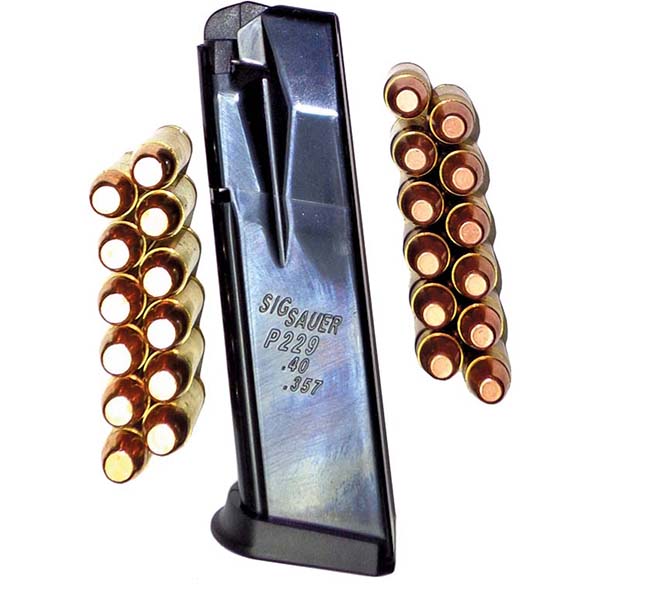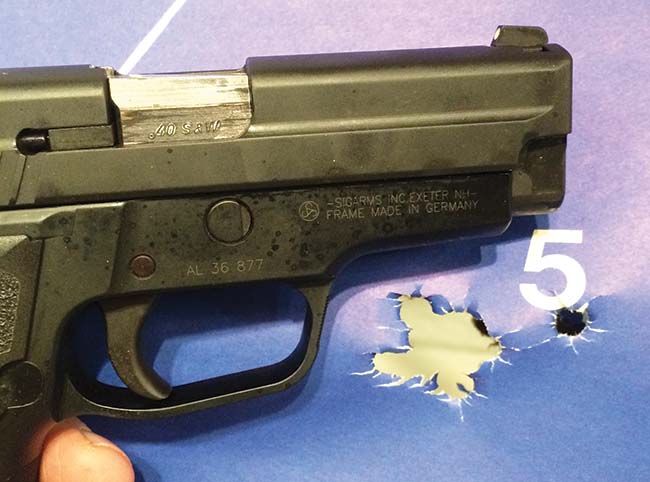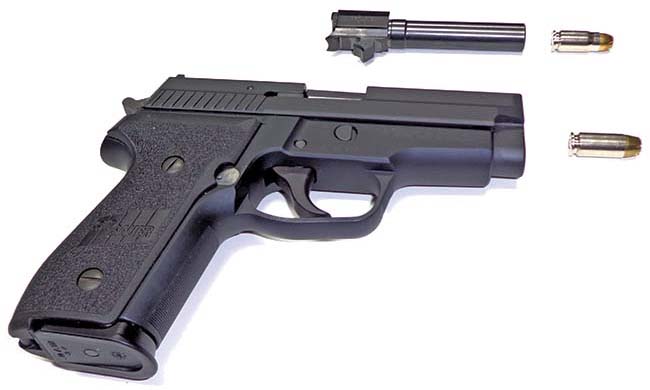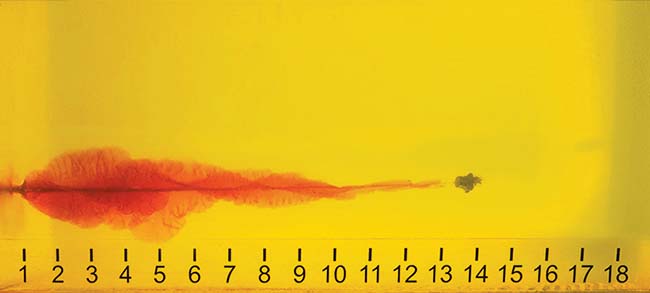ABOVE: The SIG P229 with the .357 SIG barrel installed fired at 15 yards off hand with Hornady 135 grain Critical Duty FlexLock. This group measured under 3 inches. The recoil of this round was quite manageable but still a little on the snappy side.
In January of 1990 a new cartridge hit the market that would pretty much be a game changer as to the cartridge preferred by law enforcement. The product of a joint effort between Smith & Wesson and Winchester would spawn the .40 S&W cartridge. The .40 caliber cartridges roots go back to the 10mm Auto cartridge when it was tested by the FBI as a potential replacement for their 9x19mm caliber pistols and .38 Special/.357 Magnum caliber revolvers. When tested, the FBI found two major problems with the 10mm Auto caliber firearm. First was the heavy recoil and second was that the current pistols did not hold up to the potent round. Due to the power it was difficult if not impossible to make a small compact version of the pistol. What if you could make a 10mm Short? Reduce the powder charge to make recoil manageable and shorten the overall length of the 10mm cartridge so it will fit in a 9x19mm size magazine/mid size pistol frame? Thus, here is the introduction of the .40 S&W. The first defensive cartridges in this new caliber were Winchester 180 grain jacketed hollow points.
At the point of the caliber’s introduction, oddly enough it was not Smith & Wesson that was the first to get a pistol to market. The Glock 22 was the first pistol sold in the new chambering announced one week before the release of the Smith & Wesson 4006. Due to the higher pressure of the .40 caliber compared to the 9x19mm, several concerns surfaced regarding the suitability of a 9x19mm pistol just being upsized to fit the new round. Heckler & Koch was the first company to build a pistol for the new round, this was the USP pistol.

The .40 S&W or 10mm Short fires projectile weights between 135 and 200 grains. The most popular being the 155 and the 180 grain. From a 4 inch barrel, the 155 grain projectile is launched at 1,205 feet per second with 500 foot pounds of energy. That same barrel will launch a 180 grain projectile at 1,050 feet per second with a muzzle energy of 441 foot pounds. Unlike the 10mm, the .40 caliber uses a small pistol primer rather than large. The larger 200 grain projectile is rather uncommon.
For SIG Sauer, some different things were going on at the time of the introduction of the .40 cal. cartridge. First, SIG now had manufacturing capability in their New Hampshire facility. SIG engineers looked at the .40 caliber cartridge and were not so sure that they could simply enlarge the breech face and barrel on a P228 and make a reliable and durable pistol. They felt that the pistol should be made around the cartridge and not the other way around. So SIG engineers went on to redesign the slide entirely for the new caliber. Instead of the traditional stamped steel slide with a breech insert pinned into it, the new slide was to be made from a single block of stainless steel. Modern CNC machines would transform this block into a heavy duty slide. Once the slide was completed it would be finished with a black Nitron finish. Additionally, a new braided recoil spring was designed with an extra strand to offer more resistance to deal with the higher slide velocity. Now enter the SIG Sauer P229 pistol, a service pistol designed to shoot the new .40 cal. round. The barrel is rifled with a right 1 turn in 16 inch twist.

The P229 was completely comparable to the size of the P228. The slide dimensions were slightly different causing it to need its own holster. Like all SIG pistols, they were very simple to operate. They had no manual safety. Looked at favorably by some and negatively by others, the SIG pistol offered a double action/single action trigger pull. Once the pistol was loaded, the hammer was decocked via a decocking lever on the left side of the pistol. To fire, the first pull is a long approximately 10 pound double action trigger. Once the pistol fires, all consecutive rounds will be a lighter approximately 4.4 pound single action pull. Of course at any time the decocking lever may be engaged to return the hammer to the double action position. The SIG pistol also uses a passive firing pin block, which was a major breakthrough in safety. Unlike the GI M1911-type pistols that one could drop on the muzzle with the safety engaged at 5 feet and have an unintentional discharge due to the inertia of the free floating firing pin, the SIG P229 could not fire unless the trigger was pulled all the way to the rear. There is a spring loaded plunger in the slide that blocks the forward movement of the firing pin that is disengaged by an arm in the frame when the trigger is pulled all the way to the rear. For a right handed shooter, the magazine release, decocking lever and slide release are all within sweeping distance of the right hand shooter’s thumb. The pistol is not so friendly for a left handed shooter. Instead of using the slide release the lefty would slingshot the slide by manually pulling it to the rear. He would use his trigger finger to actuate the decocking lever and magazine release. The magazine holds 12 rounds of .40 caliber ammunition. The barrel length is 3.9 inches and the P229’s overall length is 7.1 inches. The height of the pistol is 5.4 inches with a width of 1.5 inches. The weight of the P229 pistol is 32 oz.
Very quickly, other manufactures of ammunition began offering various loads. Law enforcement ammunition would include the proven Federal Hydra Shok, Winchester Silver Tip and at this same time Winchester introduced their Black Talon load. As time has gone by other loads such as the Federal HST, CCI Gold Dot, Remington Golden Saber, Winchester T-Series and Hornady XTP and Critical Duty FlexLock ammunition have been introduced and used by Law Enforcement. The P229 immediately was a hit. Federal Law Enforcement was one of the first to pick it up. The pistol is in use by the Secret Service, BATF, ICE and Postal Inspectors to name a few. Numerous PDs throughout the country adopted it. The biggest hindrance of the SIG achieving maximum sales was the high price compared to the competing Smith & Wesson, Glock and Beretta pistols.

In 1994, SIG for the first time introduced a new cartridge. In cooperation with Federal Cartridge Company, SIG developed the .357 SIG. The name describes the design intent, which was to duplicate the performance of the .357 Magnum 125 grain load in a semiautomatic pistol. The cartridge case started with a .40 caliber and is necked down (bottleneck) to accept a .355 inch diameter projectile. This was also ground breaking since it is the first production bottlenecked cartridge for a pistol since the 1960s. Due to the bottleneck shape of the cartridge case, feeding problems are nonexistent in any pistol chambered in the .357 SIG cartridge. Round and flat tip designed projectiles load with ease. The .357 SIG launches a 125 grain projectile at 1,450 feet per second with a muzzle energy of 584 ft/s and a 115 grain projectile at 1,550 feet per second with a muzzle energy of 614 ft/s in a 4 inch barrel. SIG offered this new caliber in their popular P229 platform. The .357 SIG load projectile weights ranging from 115 to 150 grains. Load energies range from 488 foot pounds to 568 foot pounds with penetration in gel from 9 to 16.5 inches. Depending on the need for terminal performance to barrier performance, the .357 SIG has a load. Due to the relatively high velocity, the projectile shoots rather flat and imparts high amount of hydrostatic shock on the target. As engineering genius would have it, all that was needed to convert the P229 to .357 SIG was a new barrel. Since the parent case is .40 cal, the same slide and magazine are used. Most .40 cal. pistols could be converted but special attention need be given that the recoil spring is strong enough for use with the .357 SIG. The second manufacturer to come out with a production pistol chambered in the .357 SIG cartridge was Glock with the G37, G38 and G39.
When the cartridge first appeared, Federal was the only company making ammunition for it. The loads offered were at best defense ammunition. There was no inexpensive training ammunition. This hindered the cartridge from getting the initial popularity it could have. However, over these intervening years, all major U.S. manufactures provide both inexpensive target/training ammunition as well as many excellent high performance hollow points. Training ammunition consists of full metal jacket and frangible ammunition. The high performance hollow points include Federal HST, Remington Bonded Golden Saber, Speer Gold Dot, Winchester T-Series and Hornady Critical Duty FlexLock ammunition.

As time went on the P229 was introduced in 9x19mm caliber effectively eliminating the P228 from SIG’s line-up. The slide is made in the same manner but additional material removed to make the slide function properly with the lighter 9x19mm cartridge. Many different models were introduced featuring various finishes including two tone, Equinox, stainless steel and flat dark earth. Models were offered with extended barrels to permit the attachment of sound suppressors (P229 Scorpion TB). Also offered are trigger options such as the standard double/single, DAK (6 1/2 pound double action only with double strike capability) and SRT (Short Reset Trigger that reduces length of travel). Various grips are offered including standard factory polymer, custom shop wood, Hogue Extreme and one piece reduced reach Ergo grips. Furthermore, the P229 is now offered with a Mil-Std 1913 rail on the frame.
The first police department to issue the new .357 SIG P229 was the Texas Highway Patrol. Other agencies that have adopted it include Delaware State Police, Virginia State Police, Orlando PD, Montana Highway Patrol and Rhode Island State Police. Federal agencies have also adopted the weapon system including the U.S. Secret Service, Bureau of Industry and Security as well as Federal Air Marshalls. Additional agencies use the .357 SIG cartridge chambered in other manufacturers pistols such as the Smith & Wesson M&P and Glock pistols.
The pistol tested was a 2006 vintage SIG P229 originally chambered in .40 caliber. This was pre Mil-Std 1913 rail. For testing, a separate .357 SIG barrel was procured from SIG Sauer. The double action trigger broke at 10 1/4 pounds and the single action trigger at 4 1/2 pounds. There were 6 magazines used to test fire the pistol including two early 12-round magazines, 2 new production 12-round magazines (made in Italy) and two older 10-round magazines.
Numerous types of ammunition were procured for testing this pistol in both .40 and .357 SIG calibers. This author wanted to see how the pistol shot with both barrels but also see what ammunition was available and how reliable the pistol was with the various rounds. All groups were shot at 15 yards off hand.
The first test was the .357 SIG barrel in the P229. There were 100 rounds of Federal American Eagle 125 grain full metal jacket rounds fired for function testing. There were no malfunctions of any sort. There were 12 rounds of each of these loads fired to test reliability: Federal HST, Remington Golden Saber, Federal Tactical Hollow Point and Hornady Critical Duty FlexLock. There were no malfunctions with any of the ammunition fed to the P229. Recoil was a bit stout, noticeably more than a 9mm and a much more pronounced muzzle flash/blast. However, recoil was less than that of the .40 caliber round. Accuracy off-hand was excellent with the best being the Hornady Critical Duty load coming in under 3 inches at 15 yards. Perhaps off of a rest that would have tightened up quite a bit but a rest was not available.

Then the P229 was tested in .40 caliber. The pistol was broken down and the barrel swapped out with the .40 cal. one. For safety, do not have any ammunition on the bench other than the caliber you are shooting. It is not safe to fire a .357 SIG round in a .40 caliber chamber. The same magazines were loaded up with 100 rounds of Federal American Eagle 180 grain full metal jacket flat point for function testing. This load actually gave the best group coming in at just under 2 inches off hand. To check ammunition reliability, 12 rounds of each of these loads were fired: Federal HST, Federal Hydra Shok, Remington Golden Saber, Federal Tactical Hollow Point, CCI Gold Dot and Hornady Critical Duty FlexLock. Once again there were no malfunctions of any kind. There was little change in impact from switching between calibers. This pistol shot 2 inches to the left for me. If the sight was adjusted all groups would have been center hits.
The SIG P229 is an excellent choice for either a duty or a personal protection firearm. The Coast Guard has adopted the P229 in .40 caliber for their new duty pistol to replace the M9. Since they are under Department of Homeland Security instead of Department of Defense they can now upgrade small arms as well as ammunition. They are using a hollow point projectile instead of full metal jacket. The adaptability to both calibers is certainly a plus. The barrel is not expensive for either caliber. Ammunition for both is readily available and offered in many different high performance loads. The price is not cheap but anyone who buys a SIG knows what they are paying that money for and rarely if ever disappointed.











